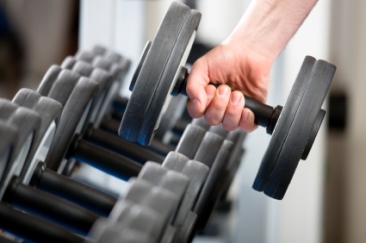In today's hyper-competitive youth sports environment, young athletes are constantly seeking ways to gain an advantage; so much so, in fact, that kids have begun rushing into the weight room in record numbers.
As a strength and conditioning coach, I completely understand and appreciate a young athlete's desire to become bigger, faster and stronger, but to do so before laying a sound physical foundation is a mistake; one that can often lead to serious long term consequences.
Strength and weight training: not the same
Too many young athletes, as well as many coaches and parents, are under the mistaken impression that strength training and weight training are one and the same. They aren't.
Weight training, as the name implies, involves the use of external loading (usually in the form of free weights and machines) as a means of increasing both size and strength.
Strength training, on the other hand, refers to the process of getting stronger as a result of repeated exposure to some type of resistance. It doesn't matter if that resistance comes in the form of rubber tubing, medicine balls, rocks, sticks, or even your own body weight. As long as the resistance imposes enough of a physical overload on the athlete's body, he will become stronger. 
Control body first
So why the big distinction? Because, as far as overall athletic development is concerned, young athletes are best served learning to control their own body weight first, before moving on to any type of additional resistance.
Think about it for a minute: if a kid can't do a simple squat without their knees pinching together, their spine rounding forward, or visibly shifting their weight to one side, does it make sense to place a loaded barbell on their back? (To say nothing of the legions of kids who make a bee-line for the bench press, without possessing the core strength to do a single push-up with proper form.) Chances are, sooner or later this type of imbalanced approach will result in movement restrictions that will end up adversely affecting athletic performance.
Whether these limitations are a result of lack of body awareness, mobility issues involving particular joints, or strength imbalances that have resulted form poor postural habits, or chronic overuse, they need to be addressed before kids can start loading up on weights. It's an approach that will help get them moving better and be able to derive even greater benefit from weight training once they're physically prepared for it.
Weight machines not the answer
This is not to say that weight training is somehow inherently dangerous, because it isn't. As numerous studies over the years have demonstrated, while adolescents are indeed at increased risk for growth plate fractures, a well-designed, properly supervised strength training program is actually safer than many forms of sports participation. The problem is that some of the programs in which kids participate are not well-designed or properly supervised!
Weight machines do not offer a better alternative. Often times they expose kids to even more potential dangers than free weights because many machines only provide two-dimensional resistance, where all you have to do is move the weight along some predetermined path. This simply isn't the way our bodies were designed to move. When an athlete exerts muscular effort on the field of play, there's a constant interplay going on between stability and mobility that you just can't replicate on traditional weight machines. The exceptions are cable-based systems, Keiser machines that use pneumatic pressure, and Free Motion equipment.
Kinetic chain
Hopping on some state-of-the-art gizmo and focusing on pumping up their pecs or quads might help your child look a little more "buff", but it will do next to nothing for his ability to run, jump, shed a block, or maintain his balance while attempting to elude a defender. That's because our muscles weren't designed to move in isolation, but rather as part as part of a larger kinetic chain.
Everything from throwing a baseball to swinging a golf club involves a complex sequence of muscular actions that we just can't prepare for by isolating specific muscles. Not to mention that fact that doing so may actually increase the risk of injury.
All systems go!
If a chain is only as strong as its weakest link, and your child is constantly isolating his strongest muscles with exercises, chest flys and biceps curls, there's inevitably going to be a breakdown at some point. That's why, when it comes to young athletes, I recommend a more systemic approach to strengthening.
In my next article I'll outline a complete workout containing some of my favorite body weight drills for kids. Have your child give it a try and see if it's not significantly harder than the typical "gym based" approach he may be used to.
Mike Mejia MS, CSCS is the president of B.A.S.E. Sports Conditioning Inc. and a frequent contributor to numerous nationally recognized magazines and websites on the subject of youth athletic development.
Posted November 16, 2011








